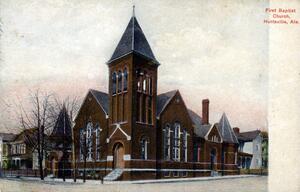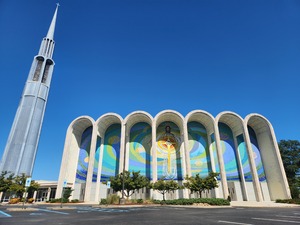
First Baptist Church of Huntsville Alabama
David Liles, Fall 2024
The story of First Baptist Church Huntsville begins in rural northern Alabama where a group of pioneers banded together in 1809 to form a Baptist church. They originally were named West Fork of Flint River Baptist Church, but soon renamed to Enon Baptist Church. They settled on that name because it was more meaningful and displayed their stance on a controversial belief in Christianity at the time. The name Enon referred to a river John the Baptist was baptizing new believers in the New Testament. At the time, the stance of believer’s baptism was frowned upon by many Christians in the area who were of denominations where baptism at birth was commonplace, such as Methodism and Calvinism.
Despite the challenges that came from this, the church decided to affiliate with the Flint River association in 1814. The next year, they built the church’s first log meeting house. At the time, they only held services monthly because of the strenuous life that came from living on the frontier. 10 years later, after many technological improvements and the rapid growth of the area, they were able to construct a new brick meetinghouse nearby that provided a more stable church home for the area. The church would later have disputes within the Flint River association related to missionary work so when the Southern Baptist Convention was formed in 1845, the congregation of Enon Baptist would end up joining.
As Huntsville grew, many members of the church moved out of rural northern Alabama and into the city. That would later prompt discussions of moving the church to Huntsville, where much of the congregation now lived. In 1861 the discussions gave way to a new “Bell Tower Church” that was built on the corner of Clinton and Gallatin (now Spragins) and would serve the people there for many years to come. As the church neared the turn of the century new advances in technology and rapid growth of the area ushered in the change of the church’s name and a new church building. The name change and planning of the new building came first in 1893 with the new “Gothic Church” officially completed later in 1895. This “Gothic Church” is what we see in the postcard from the Southpaw Collection. I was able to date the postcard to around 1909 using Thomas’ research on American News Company postcards. This particular postcard had a Litho-Chrome stamp on the back which was one of the German styles of postcards printed during that time period.
After the completion of the new church building the congregation kept growing strong, a little too strong, into the Great Depression era. In 1927, two years before the depression had started, they had purchased a pastorium that was being slowly paid off. Unfortunately, they ended up mortgaging the pastorium for $5,000 in 1928, but it was a move that likely saved the church. However, they soon encountered another problem. In 1932, which was 3 years into the depression, they had to make space for Sunday School departments that were unable to meet on the church property at Clinton W. The initial cost of the project came out to be about $3,000 for the entire basement area. Amid the impending financial crisis, the congregation came together and cut the cost of the project by digging out parts of the basement themselves. With the help of many volunteers, the project was completed and the church moved on from the depression era a little spooked, but still standing strong.
The years following the depression and WWII were met with growth within the church and therefore more discussions of expansion. A long range planning committee was formed in 1954 to assess church growth and they concluded that there was no property near Clinton and Gallatin available for purchase to expand the current church. After much searching, the committee decided to purchase the property on Governors drive where there was ample space for the church. Soon after the purchase, which took place in 1956, the building committee got to work quickly to provide a model for the new church building. The model was completed in December of 1960 and the church ended up breaking ground in the summer of 1961. The church had their last service at the Clinton property in 1963 where the pastor quoted the church minutes from 1861 when the congregation had decided to move into Huntsville the first time. Although they moved to the new property in 1963, the new sanctuary wasn’t completed until 1965 and wasn’t used until 1966 after it was dedicated. Work started on the famous “Eggbeater Jesus” mosaic in 1966, which was later completed in 1973. The bell tower also remained unfinished until 1987. Since then, renovations have been made to the sanctuary and other various buildings, but the church is still growing strong at Governors drive where it is today.
The story of First Baptist Church Huntsville shows us the resilience and adaptability of its congregation over the years. From Enon Baptist church in rural Alabama to First Baptist Church Huntsville in the city, the church has stuck together and been obedient to God’s plan. Despite the challenges they faced, the congregation trusted God, grew closer to Him and each other, and persevered, displaying their commitment to the community. Today we see First Baptist Church as a powerful symbol of generations of believers’ faith and a testament to God’s commitment to the church and the city of Huntsville.


